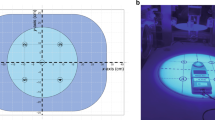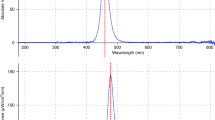Abstract
Objective:
The objective of this study is to determine whether irradiance levels of phototherapy (PT) devices in Dutch neonatal intensive care units (NICUs) increased between 2008 and 2013.
Study Design:
Irradiance of all types of PT devices, used in combination with incubators, was measured with a Dale 40 Radiometer (Fluke Biomedical, Everett, WA, USA) in all 10 Dutch NICUs.
Results:
Irradiance increased in seven NICUs. Median (range) irradiance increased from 9.7 (4.3–32.6) to 16.4 (6.8–41) μW cm−2 nm−1 for 24 overhead devices (P=0.004) and from 6.8 (0.8–15.6) to 22.3 (1.1–36.3) μW cm−2 nm−1 for 12 underneath devices (P=0.014). Five light-emitting diode (LED)-based devices were used in 2013 and one in 2008. The mean distance between overhead PT device and infant decreased by ~9 cm (P<0.001). Significantly more devices delivered minimal (10 μW cm−2 nm−1) recommended irradiance levels (80 vs ~45%; P=0.002).
Conclusion:
Irradiance of PT devices still varies, but has markedly improved since 2008 due to shorter distances between PT device and infant, and introduction of better performing LED-based devices.
This is a preview of subscription content, access via your institution
Access options
Subscribe to this journal
Receive 12 print issues and online access
$259.00 per year
only $21.58 per issue
Buy this article
- Purchase on Springer Link
- Instant access to full article PDF
Prices may be subject to local taxes which are calculated during checkout



Similar content being viewed by others
References
Maisels MJ, McDonagh AF . Phototherapy for neonatal jaundice. N Engl J Med 2008; 358: 920–928.
Bhutani VK, Committee on Fetus and Newborn; American Academy of Pediatrics. Phototherapy to prevent severe neonatal hyperbilirubinemia in the newborn infant 35 or more weeks of gestation. Pediatrics 2011; 128: e1046–e1052.
American Academy of Pediatrics Subcommittee on Hyperbilirubinemia. Management of hyperbilirubinemia in the newborn infant 35 or more weeks of gestation. Pediatrics 2004; 114: 297–316.
Cline BK, Vreman HJ, Faber K, Lou H, Donaldson KM, Amuabunosi E et al. Phototherapy device effectiveness in Nigeria: Irradiance assessment and potential for improvement. J Trop Pediatr 2013; 59: 321–325.
Satrom K, Slusher T, Satrom J . Effectiveness of phototherapy units in Cameroon. J Trop Pediatr 2014; 60: 264–266.
Van Imhoff DE, Hulzebos CV, van der Heide M, van den Belt VW, Vreman HJ, Dijk PH et al. High variability and low irradiance of phototherapy devices in Dutch NICUs. Arch Dis Child Fetal Neonatal Ed 2013; 98: F112–F116.
Maisels MJ, Watchko JF . Treatment of jaundice in low birthweight infants. Arch Dis Child Fetal Neonatal Ed 2003; 88: F459–F463.
Mims LC, Estrada M, Gooden DS, Caldwell RR, Kotas RV . Phototherapy for neonatal hyperbilirubinemia—a dose: response relationship. J Pediatr 1973; 83: 658–662.
Tan KL . The pattern of bilirubin response to phototherapy for neonatal hyperbilirubinaemia. Pediatr Res 1982; 16: 670–674.
Vandborg PK, Hansen BM, Greisen G, Ebbesen F . Dose-response relationship of phototherapy for hyperbilirubinemia. Pediatrics 2012; 130: e352–e357.
Bhutani VK, Cline BK, Donaldson KM, Vreman HJ . The need to implement effective phototherapy in resource-constrained settings. Semin Perinatol 2011; 35: 192–197.
Kumar P, Chawla D, Deorari A . Light-emitting diode phototherapy for unconjugated hyperbilirubinaemia in neonates. Cochrane Database Syst Rev 2011; 12: CD007969.
Viau Colindres J, Rountree C, Destarac MA, Cui Y, Pérez Valdez M, Herrera Castellanos M et al. Prospective randomized controlled study comparing low-cost LED and conventional phototherapy for treatment of neonatal hyperbilirubinemia. J Trop Pediatr 2012; 58: 178–183.
Brandão DC, Draque CM, Sañudo A, de Gusmão Filho FA, de Almeida MF . LED versus daylight phototherapy at low irradiance in newborns ≥35 weeks of gestation: randomized controlled trial. J Matern Fetal Neonatal Med 2015; 28: 1725–1730.
Olusanya BO, Osibanjo FB, Emokpae AA, Slusher TM . Irradiance decay in fluorescent and light-emitting diode-based phototherapy devices: a pilot study. J Trop Pediatr 2016; 62: 421–424.
Brown AK, Kim MH, Wu PY, Bryla DA . Efficacy of phototherapy in prevention and management of neonatal hyperbilirubinemia. Pediatrics 1985; 75: 393–400.
Steiner LA, Bizzarro MJ, Ehrenkranz RA, Gallagher PG . A decline in the frequency of neonatal exchange transfusions and its effect on exchange-related morbidity and mortality. Pediatrics 2007; 120: 27–32.
Arnolda G, Thein AA, Trevisanuto D, Aung N, Nwe HM, Thin AA et al. Evaluation of a simple intervention to reduce exchange transfusion rates among inborn and outborn neonates in Myanmar, comparing pre- and post-intervention rates. BMC Pediatr 2015; 15: 216.
Morris BH, Oh W, Tyson JE, Stevenson DK, Phelps DL, O'Shea TM et al. NICHD Neonatal Research Network. Aggressive vs conservative phototherapy for infants with extremely low birth weight. N Engl J Med 2008; 359 (18): 1885–1896.
Wickremasinghe AC, Kuzniewicz MW, Grimes BA, McCulloch CE, Newman TB . Neonatal phototherapy and infantile cancer. Pediatrics 2016; 137 (6)pii: e20151353 doi:10.1542/peds.2015-1353.
Vreman HJ . Phototherapy: the challenge to accurately measure irradiance. Ind Pediatr 2010; 47: 127–128.
Acknowledgements
The BARTtrial Study Group members are:
MJNL Benders, MD, PhD. Division of Neonatology, Wilhelmina Children's Hospital, University Medical Center Utrecht.
J Buijs, MD. Department of Pediatrics, Maxima Medical Center Veldhoven
J Dudink, MD, PhD. Department of Neonatology, Sophia Children’s Hospital, Erasmus Medical Center Rotterdam.
DE van Imhoff, MD, PhD; PH Dijk, MD, PhD; CV Hulzebos, MD, PhD. Department of Neonatology, Beatrix Children’s Hospital, University Medical Center Groningen
CR Laarman, MD. Division of Neonatology, Department of Pediatrics, VU University Medical Center, Amsterdam.
KD Liem, MD, PhD. Division of Neonatology, Department of Pediatrics, Radboud University Medical Centre, Nijmegen.
RA van Lingen, MD, PhD. Division of Neonatology, Princess Amalia Department of Pediatrics, Isala Clinics, Zwolle.
E Lopriore, MD, PhD. Division of Neonatology, Department of Pediatrics, Leiden University Medical Center.
ALM Mulder, MD, PhD. Department of Pediatrics, Maastricht University Medical Center, GROW-School for Oncology and Developmental Biology, Maastricht.
L van Toledo-Eppinga, MD, PhD. Department of Neonatology, Emma Children’s Hospital, Academic Medical Center University of Amsterdam.
Author information
Authors and Affiliations
Consortia
Corresponding author
Ethics declarations
Competing interests
The authors declare no conflict of interest.
Rights and permissions
About this article
Cite this article
Hulzebos, C., van't Klooster, S., Lorenz, K. et al. Irradiance levels of phototherapy devices: a national study in Dutch neonatal intensive care units. J Perinatol 37, 839–842 (2017). https://doi.org/10.1038/jp.2017.13
Received:
Revised:
Accepted:
Published:
Issue Date:
DOI: https://doi.org/10.1038/jp.2017.13
This article is cited by
-
Irradiance footprint of phototherapy devices: a comparative study
Pediatric Research (2022)
-
Current phototherapy practice on Java, Indonesia
BMC Pediatrics (2019)



